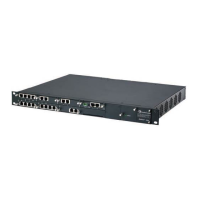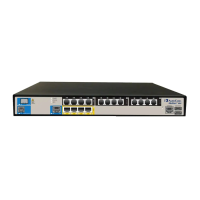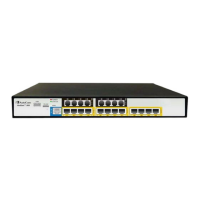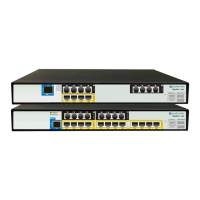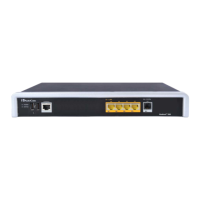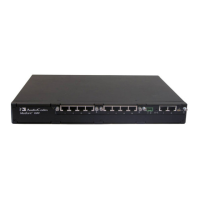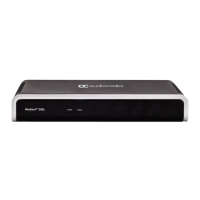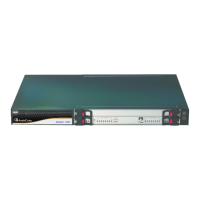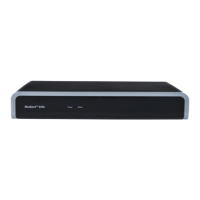Do you have a question about the AudioCodes Mediant 8000 and is the answer not in the manual?
Details the SC Rev.1 board, based on SUN CP2300 SBC, running SUN Solaris 9 OS.
Details the SC Rev.2 board, a next-generation board using Intel CPU and running Linux OS.
Explains the necessary IP network connectivity for proper operation of the Mediant 8000.
Guides on allocating IP addresses for all Mediant 8000 components, including subnet mask and default gateway.
Details preparing PSTN connections based on Media Gateway board types (TP-6310 or TP-8410).
Provides instructions for mounting the Mediant 8000 chassis on a rack, including safety precautions.
Details the procedure for earthing the Mediant 8000 chassis to a stable local earth reference.
Outlines the steps for powering up the Mediant 8000 after mounting and earthing.
Details connecting to the CLI via RS-232 serial console when IP connectivity is unavailable.
Describes connecting to the CLI via SSH or Telnet clients when IP connectivity is available.
Guides on configuring basic IP network parameters on SC boards prior to connecting to the external IP network.
Explains the software installation process on the SC boards, noting it's often pre-installed.
Details performing basic configuration of the software, redefining high-level parameters and ensuring network configuration match.
Details configuring connectivity between the Mediant 8000 and the EMS Server using the 'tools ems' command.
Describes monitoring gateway functionality and service status via polling and trap notifications.
Guides on configuring connectivity between the Media Gateway and EMS Server after initial software installation or parameter modification.
Explains establishing IP network configuration via EMS GUI, including resetting ES boards.
Details IP network connectivity configuration on SC boards for management equipment exchange.
Guides on configuring IP network connectivity on Media Gateway boards for all IP traffic types.
Explains connecting the Mediant 8000 to the IP network after completing configuration and activating it.
Describes how Media Gateway boards are grouped into Redundancy Groups operating in an N+1 redundant mode.
Explains Redundancy Groups and the dedicated redundant board providing hot redundancy protection.
Outlines tasks for configuring MGCP/MEGACO Call Control settings, including Virtual Gateways and Controllers.
Guides on configuring the V5.2 Access Gateway application, including PSTN parameters, trunks, interfaces, links, and user ports.
Provides guidelines for implementing basic security features, including secure operation modes and protocols.
Explains enabling Secure Operation Mode as a first step towards secure configuration and other security features.
Details achieving secure CLI access via SSH protocol and associated file transfer protocols SCP and SFTP.
Details OS security patches automatically installed during Mediant 8000 installation or Online Software Upgrade.
Explains X.509 as an ITU-T standard for Public Key Infrastructure used in security applications.
Describes IPSEC and IKE protocols for secured IP connections between applications, providing security for call control and management.
Describes Firewall functionality on Media Gateway boards to protect against unauthorized access.
Provides instructions on administering users (add/delete/modify) on the Mediant 8000 CLI.
Guides on configuring Performance Monitoring Profiles for a Media Gateway entity, including attaching and activating polling.
Details customizing threshold values for History PMs to generate alarms when thresholds are exceeded.
Details CPT files containing definitions of Call Progress and User-Defined Tones, and their configuration types.
Describes PRT files providing flexible tone generation, consisting of PCM (WAV) files.
Details Voice Prompts files containing definitions of voice prompts played by the Media Gateway board upon MGC request.
Details basic PSTN subsystem configuration for each Media Gateway board.
Describes defining a connection between switches within the PSTN exchange using E1/T1 trunks.
Describes SS7 as a global standard for telecommunications, defining procedures and protocols for PSTN network elements.
Explains using SIP Proxy servers for routing SIP requests, recommending a centralized architecture.
Allows configuration of different aspects of SIP call control protocol implementation.
Explains configuring Coder Groups to define up to 10 groups of coders with packetization time, rate, payload type, and silence suppression.
Guides on configuring the Coder's table, noting each coder can be defined only once.
Explains the LCR feature for choosing outbound IP destination routing rules based on lowest call cost.
Enables call routing decisions based on information stored on a third-party LDAP server.
Details IP-to-IP call routing functionality, enabling seamless connection of IP-PBX to SIP trunks.
Describes Profile tables for adapting Media Gateway to various equipment and protocols.
Guides on performing basic configuration of the SAS application.
Lists the functionality provided by the SBC application: VoIP firewall, topology hiding, admission control, routing, etc.
Describes basic configuration of the SBC application.
Details the SBC routing scheme, including routing rules and multiple destination types.
Guides on creating Media Gateway software backup via EMS GUI or CLI.
Explains restoring Media Gateway software from backup file, requiring restoration on both SC boards.
Details replacing a failed SC board, including installing OS, configuring IP address, and installing software.
Describes replacing failed Media Gateway boards (TP-6310 and TP-8410), noting they are hot-swappable.
Provides troubleshooting steps if a newly installed Media Gateway board does not return to service after Unlock.
Details replacing Ethernet Switch boards, including locking/unlocking procedures in EMS.
Describes replacing Power Supply Modules (PS/DC/8K).
Explains the Online Software Upgrade process performed on a running Mediant 8000, upgrading all components and preserving configuration.
Emphasizes performing a full Media Gateway software backup before Online Software Upgrade for rollback capability.
Lists conditions that must be met before starting the Online Software Upgrade.
Outlines the stages of the Online Software Upgrade Wizard.
Advises performing software backup after upgrade and manually activating new features.
Explains performing rollback to previous software configuration via Abort button or automatic trigger on failure.
Provides guidance on troubleshooting problems during online software upgrade or rollback.
Describes the maintenance philosophy focused on locating faulty components and replacing them.
Describes configuring Media Gateway to operate with Cisco Hot Standby Routing Protocol (HSRP) or VRRP.
Details the SC Rev.1 board, based on SUN CP2300 SBC, running SUN Solaris 9 OS.
Details the SC Rev.2 board, a next-generation board using Intel CPU and running Linux OS.
Explains the necessary IP network connectivity for proper operation of the Mediant 8000.
Guides on allocating IP addresses for all Mediant 8000 components, including subnet mask and default gateway.
Details preparing PSTN connections based on Media Gateway board types (TP-6310 or TP-8410).
Provides instructions for mounting the Mediant 8000 chassis on a rack, including safety precautions.
Details the procedure for earthing the Mediant 8000 chassis to a stable local earth reference.
Outlines the steps for powering up the Mediant 8000 after mounting and earthing.
Details connecting to the CLI via RS-232 serial console when IP connectivity is unavailable.
Describes connecting to the CLI via SSH or Telnet clients when IP connectivity is available.
Guides on configuring basic IP network parameters on SC boards prior to connecting to the external IP network.
Explains the software installation process on the SC boards, noting it's often pre-installed.
Details performing basic configuration of the software, redefining high-level parameters and ensuring network configuration match.
Details configuring connectivity between the Mediant 8000 and the EMS Server using the 'tools ems' command.
Describes monitoring gateway functionality and service status via polling and trap notifications.
Guides on configuring connectivity between the Media Gateway and EMS Server after initial software installation or parameter modification.
Explains establishing IP network configuration via EMS GUI, including resetting ES boards.
Details IP network connectivity configuration on SC boards for management equipment exchange.
Guides on configuring IP network connectivity on Media Gateway boards for all IP traffic types.
Explains connecting the Mediant 8000 to the IP network after completing configuration and activating it.
Describes how Media Gateway boards are grouped into Redundancy Groups operating in an N+1 redundant mode.
Explains Redundancy Groups and the dedicated redundant board providing hot redundancy protection.
Outlines tasks for configuring MGCP/MEGACO Call Control settings, including Virtual Gateways and Controllers.
Guides on configuring the V5.2 Access Gateway application, including PSTN parameters, trunks, interfaces, links, and user ports.
Provides guidelines for implementing basic security features, including secure operation modes and protocols.
Explains enabling Secure Operation Mode as a first step towards secure configuration and other security features.
Details achieving secure CLI access via SSH protocol and associated file transfer protocols SCP and SFTP.
Details OS security patches automatically installed during Mediant 8000 installation or Online Software Upgrade.
Explains X.509 as an ITU-T standard for Public Key Infrastructure used in security applications.
Describes IPSEC and IKE protocols for secured IP connections between applications, providing security for call control and management.
Describes Firewall functionality on Media Gateway boards to protect against unauthorized access.
Provides instructions on administering users (add/delete/modify) on the Mediant 8000 CLI.
Guides on configuring Performance Monitoring Profiles for a Media Gateway entity, including attaching and activating polling.
Details customizing threshold values for History PMs to generate alarms when thresholds are exceeded.
Details CPT files containing definitions of Call Progress and User-Defined Tones, and their configuration types.
Describes PRT files providing flexible tone generation, consisting of PCM (WAV) files.
Details Voice Prompts files containing definitions of voice prompts played by the Media Gateway board upon MGC request.
Details basic PSTN subsystem configuration for each Media Gateway board.
Describes defining a connection between switches within the PSTN exchange using E1/T1 trunks.
Describes SS7 as a global standard for telecommunications, defining procedures and protocols for PSTN network elements.
Explains using SIP Proxy servers for routing SIP requests, recommending a centralized architecture.
Allows configuration of different aspects of SIP call control protocol implementation.
Explains configuring Coder Groups to define up to 10 groups of coders with packetization time, rate, payload type, and silence suppression.
Guides on configuring the Coder's table, noting each coder can be defined only once.
Explains the LCR feature for choosing outbound IP destination routing rules based on lowest call cost.
Enables call routing decisions based on information stored on a third-party LDAP server.
Details IP-to-IP call routing functionality, enabling seamless connection of IP-PBX to SIP trunks.
Describes Profile tables for adapting Media Gateway to various equipment and protocols.
Guides on performing basic configuration of the SAS application.
Lists the functionality provided by the SBC application: VoIP firewall, topology hiding, admission control, routing, etc.
Describes basic configuration of the SBC application.
Details the SBC routing scheme, including routing rules and multiple destination types.
Guides on creating Media Gateway software backup via EMS GUI or CLI.
Explains restoring Media Gateway software from backup file, requiring restoration on both SC boards.
Details replacing a failed SC board, including installing OS, configuring IP address, and installing software.
Describes replacing failed Media Gateway boards (TP-6310 and TP-8410), noting they are hot-swappable.
Provides troubleshooting steps if a newly installed Media Gateway board does not return to service after Unlock.
Details replacing Ethernet Switch boards, including locking/unlocking procedures in EMS.
Describes replacing Power Supply Modules (PS/DC/8K).
Explains the Online Software Upgrade process performed on a running Mediant 8000, upgrading all components and preserving configuration.
Emphasizes performing a full Media Gateway software backup before Online Software Upgrade for rollback capability.
Lists conditions that must be met before starting the Online Software Upgrade.
Outlines the stages of the Online Software Upgrade Wizard.
Advises performing software backup after upgrade and manually activating new features.
Explains performing rollback to previous software configuration via Abort button or automatic trigger on failure.
Provides guidance on troubleshooting problems during online software upgrade or rollback.
Describes the maintenance philosophy focused on locating faulty components and replacing them.
Describes configuring Media Gateway to operate with Cisco Hot Standby Routing Protocol (HSRP) or VRRP.
| Product Type | Media Gateway |
|---|---|
| VoIP Protocols | SIP, H.323, MGCP |
| Power Supply | Dual redundant AC or DC power supplies |
| Interfaces | E1/T1, IP |
| Protocols Supported | SIP, H.323, MGCP |
| Voice Codecs | G.711, G.729, G.723.1, G.726 |
| Echo Cancellation | G.168 compliant |
| DTMF | In-band, SIP INFO |
| Fax Support | T.38, G.711 |
| Security | HTTPS |
| Redundancy | Power supply |
| Management Interfaces | Web GUI, SNMP, CLI |
| Operating Temperature | 0°C |
| Relative Humidity | 95% non-condensing |
